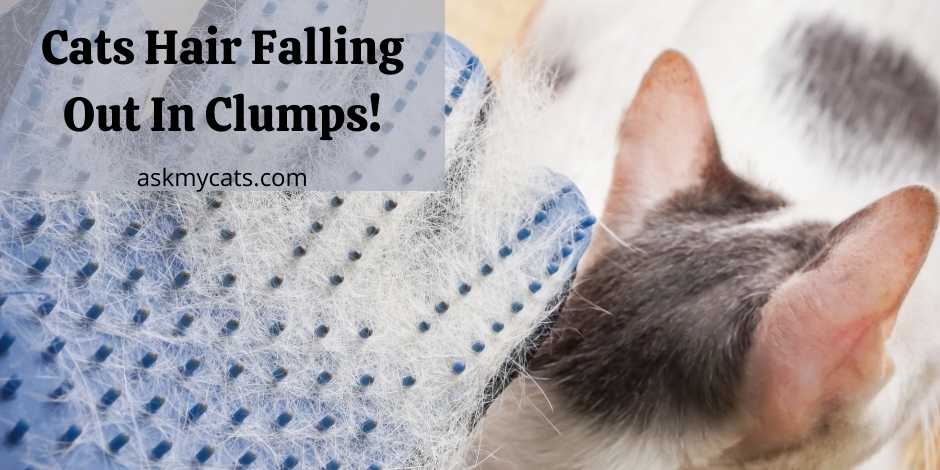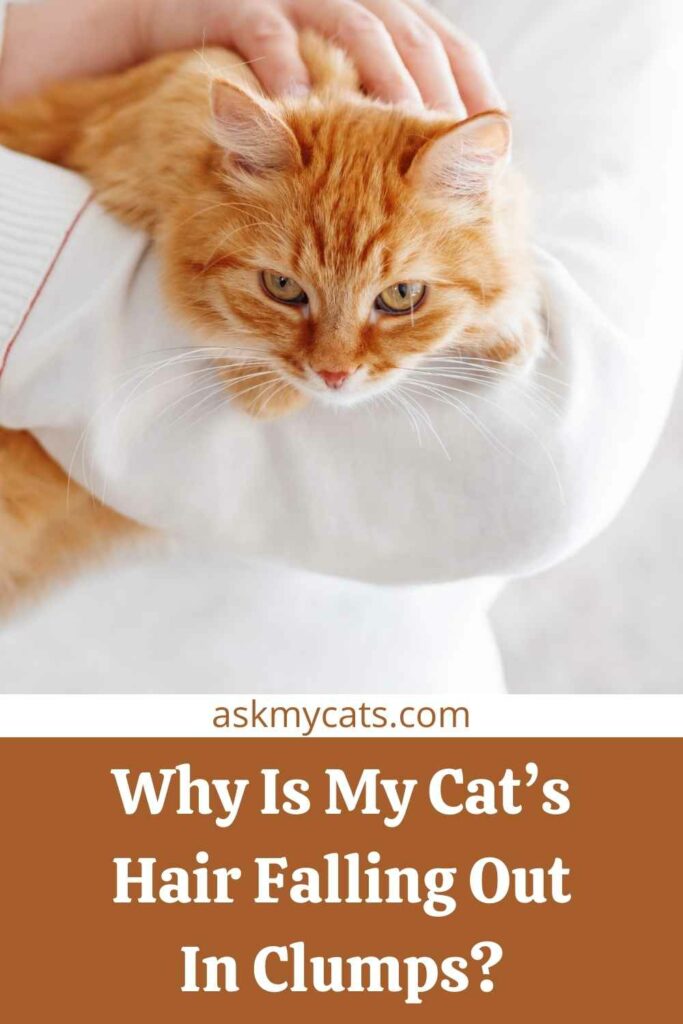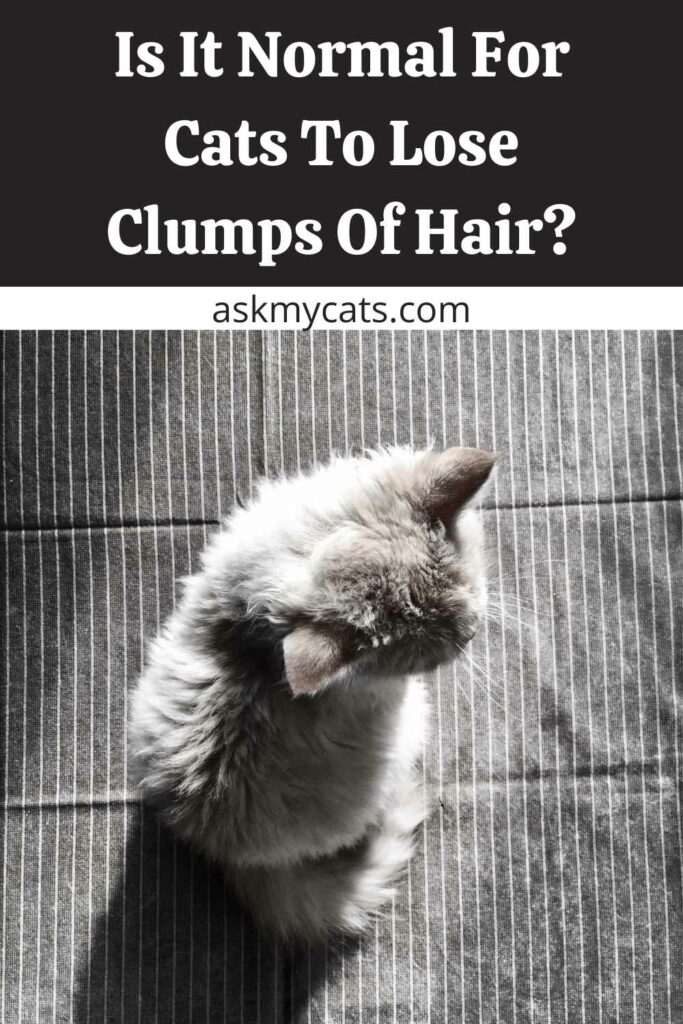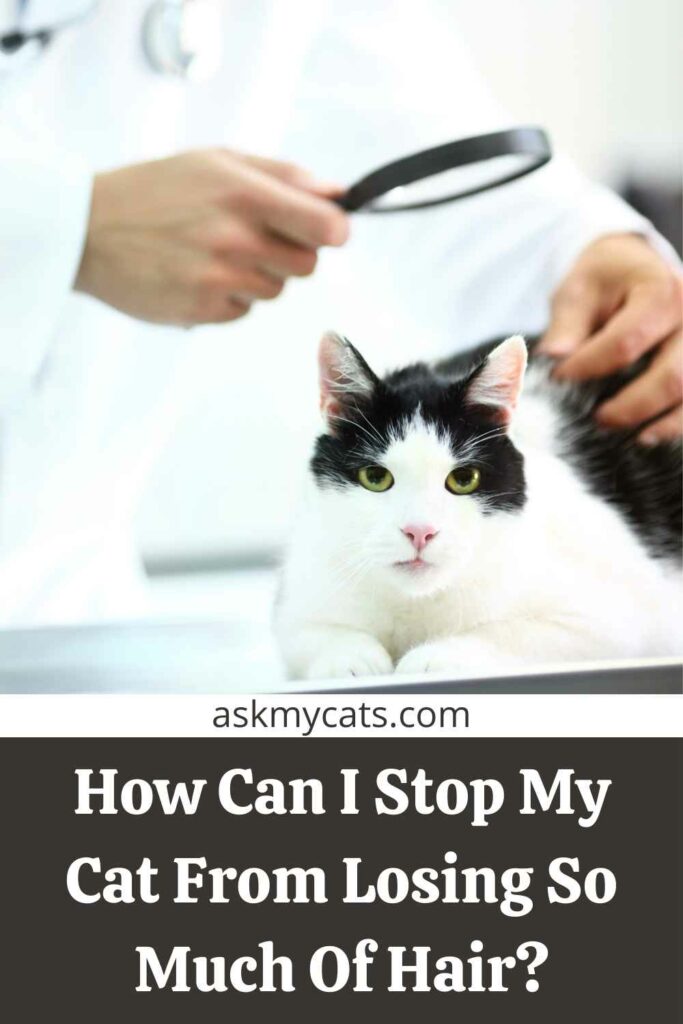Cat alopecia, or hair loss in cats, is prevalent among felines. Hair loss in cats can be partial or complete, with diverse or symmetrical patterns. The skin around the hair loss location might be expected, or it can be red, bumpy, scabby, and have skin loss.
Cat’s hair falls out in clumps due to various reasons. Some cats suffer from skin allergies, which can result in hair loss. Cat alopecia is commonly caused by mange-causing parasites and fungi such as ringworm, especially in younger cats or those with underlying health problems.
Treatment options exist, although they are restricted for many of the more prevalent reasons and depend on the source of the alopecia.


Give Your Cat the Perfect Day
Get the Free Ebook!
Why Is My Cat’s Hair Falling Out In Clumps?
Your cat is losing hair in clumps because he feels stressed and shows it through excessive scratching.

1. Stress
During your cat’s lifetime, you may observe fur thinning, fall-out, or even the removal of clumps of hair. Fur loss can make your cat feel uneasy and make them more vulnerable to diseases.
It happens for a variety of causes. As a result, it’s critical to understand some of these elements so you can get to the core of the problem. Keeping your cat’s coat in good shape will help it live a longer, healthier, and more pleasant life.
Cats can get agitated and express it by scratching excessively. In cats, unusual scratching can result in significant regions of hair loss. In this instance, you’ll need to examine your cat’s surroundings for anything that has changed.
Death or relocation of another family pet or member, as well as the arrival of a new pet at home, are all changes in a cat’s surroundings that might influence its hair.
Also, check out about do cats shed more when stressed
2. Itches
Cats with fleas will develop bald patches due to their constant scratching. In this circumstance, the best course of action is to consult a veterinarian to confirm that the animal is adequately treated and that all fleas have been removed.
Veterinarians can determine the cause of your cat’s sickness and recommend the best strategy to care for their hair as it adjusts to changes over time.
3. Lack Of Nutrients
Fur loss occurs due to aging in cats over vast portions of their bodies. The hair appears dry beneath the skin, and any fur that comes back as a replacement is generally a different color. Veterinarians attribute the disease to a lack of nourishment.
Some cats, in particular, require more nutrients in their bodies as they become older. As a result, while choosing cat food, search for products that include just natural ingredients and a few fillers.
Additionally, nutritional supplements such as powdered vitamins can be added to diets to help reverse the condition.
4. Need To Be Careful
In some circumstances, you may notice lost fur on various sections of your cat’s body. Scratches and bloody sports are among the other sights to behold. In this case, you should pay attention to how your cat interacts with the other animals in the area.
This will assist you in detecting any unusual behavior or conflicts that may result in fur loss. You should consider separating the animals or keeping your cat indoors if you witness anything resembling rough play or violent fighting.
5. Sick Cat
Fur loss in cats can also be caused by underlying disorders such as thyroid problems and allergic responses. One of the most efficient strategies to control fur loss is to treat these disorders.
If you attempt everything to keep your cat’s hair in good shape but still have problems, you should take the cat to a veterinarian clinic for a checkup.
Veterinarian inspections can discover the underlying causes of your cat’s losing fur. The doctor will determine the condition and provide the best treatment option for your cat.
Also, check out Why Is My Pregnant Cat Losing Hair?
Is It Normal For Cats To Lose Clumps Of Hair?
If your cat regularly sheds clumps of hair, you need to be cautious.

Every cat has its unique shedding cycle; some shed a tiny amount of hair while others shed a significant amount.
In any event, excessive shedding to the point where the coat becomes very thin is the reason for concern and will almost certainly result in a vet appointment.
Red or inflammatory skin might sometimes indicate an underlying disease underneath the hair.
Cats groom themselves every day and consume a lot of hair, but if yours starts vomiting or creating hairballs more frequently, it might indicate a problem with excessive hair loss.
Expect to observe hair trails around the house, but regular clusters of it are a warning flag.
Shedding is a natural part of the cat’s life; they shed every day and go through one or two more enormous hair loss and growth cycles each year.
Also, check out the reasons behind older cat shedding excessively
Another indicator of hair loss is the condition of your cat’s coat. The coat of a healthy cat with appropriate shed and growth cycles will remain smooth, silky, and clean. A harsh, raggedy texture, on the other hand, may indicate stress, sickness, or parasites.
Over-grooming or chewing their hair to the extent of bald patches or an overall rough and unclean coat is a typical “announcement” of such problems by cats.
A veterinarian should treat sudden and quick hair loss; however, you may help out during typical shedding cycles by brushing your cat with a good pet brush.
A nice wash, as well as switching your cat’s diet to foods manufactured with natural oils, will help. Although topical oils are an option, eating oils is the most efficient way to get a healthy, glossy coat.
Interesting Read: Do Black Cats Shed?
How Much Hair Loss Is Normal For Cats?
A small amount of hair loss every day is typical for cats.
Cats spend a lot of time cleaning up after themselves. Cats groom themselves or clean up after other cats while eating, resting, or playing. It’s a particular method that helped them stay under the radar of violent predators in the first place.
Brushing out your cat’s fur coat daily helps keep things cleaner around the house, which is something that cat owners learn early on. This mutually beneficial exercise also helps to lessen the frequency of hairballs.
Cats shed daily, but large-scale sheds only happen once or twice a year. Cats shed and regenerate millions of hairs regularly, depending on breed and habitat (among other things).
Not all cats shed a thick winter undercoat in the spring or lose dry hairs in the fall to create a place for a thicker winter coat in the winter. Indoor-only cats may have a consistent shedding pattern throughout the year. Each cat sheds differently.
In general, if your cat’s coat is lustrous, thick, free of dirt, tangles, or mats, and does not seem dry or brittle, their health is probably fine. Even if you see extra hair on your clothing or furnishings, they may be just going through a standard shed.
If your cat losing hair after giving birth, then you must check out this article: Cat Losing Hair After Giving Birth: Is This Normal?
How Can I Stop My Cat From Losing So Much Of Hair?
Keep your cat on an effective flea control to avoid parasitic infections that can lead to hair loss. Provide your cat with cat toys and playtime to keep her intellectually occupied and prevent hair loss caused by neurotic diseases.

Unfortunately, most types of hair loss in cats cannot be prevented.
Do a thorough check of your cat’s skin and hair at least once a week if you notice it chewing and tugging at its fur. Part the hair with a fine-toothed comb to check different portions.
If you observe your cat clawing in one region more than another, pay close attention to it.
Also, make sure that any bedding, toys, or scratch posts aren’t aggravating the problem by rubbing the cat’s hair too harshly.
Inquire with your veterinarian about a safe topical medication to relieve discomfort and itching. Your cat will have a higher chance of recovering if you can halt the pattern of scratching and biting the affected skin.
A variety of additional therapies may be utilized to treat the underlying problem that is causing your pet’s hair loss. Consult your veterinarian to learn how treatments for infections, tumors, imbalances, and other disorders may impact your pet, as well as the dangers connected with the therapy.
This kind of medicine is used to lessen the body’s response to an allergen when skin pain and hair loss resulting from an allergic reaction. Even if an allergic response has not been discovered, this medication is considered low risk and may be used with other medicines used to treat alopecia.
You might also like to read about how long does cat hair take to grow back
Frequently Asked Questions
What does it mean when a cat loses clumps of hair?
Ringworm, mites, or flea allergies are all possible reasons for feline fur loss. Food allergies and metabolic disorders, including hyperthyroidism (the overproduction of thyroid hormones), are other possibilities.
Why does my cat’s fur fall out in clumps?
Similarly, if your cat starts losing hair in areas, clumps, or all over, it might indicate a more significant health problem. Allergic responses, hormone imbalances, and insect infestations are common reasons for cat hair loss, also known as alopecia.
How can I make my cat’s hair grow?
Some cats will require more brushing than others, but all cats will benefit from brushing regularly to remove dead hair and encourage new growth. A nutrient-dense diet with the correct quantity of protein, vitamins, and minerals is needed for healthy skin and fur.
Final Words
When cats are stressed, terrified, or worried, they tend to shed more. Cats brush themselves less frequently as they become older. This might result in increased shedding or massification of their fur.
If you have any questions, ask us in the comments section below.

My cat is 15 yrs old. The last few weeks he is washing himself and tugging at his fur. In two places he has lost his fur. His skin was fine. Now I the two places his skin has gone rough and slightly red. Can you help. He is still eating , don’t know what I can do. He doesn’t have fleas. Kind regards
It sounds like your cat may be experiencing some skin irritation. The rough, red skin and excessive grooming are common symptoms of skin irritation in cats. It’s difficult to say exactly what might be causing the irritation without more information, but it could be due to a number of things, such as an allergy, infection, or even stress.
If your cat is still eating and behaving normally, it’s likely not a serious issue. However, it’s always a good idea to have your cat checked out by a veterinarian to determine the underlying cause of the skin irritation and determine the best course of treatment. Your vet may recommend a medicated shampoo or other medication to help relieve the irritation and prevent further hair loss.
In the meantime, you can try to keep your cat comfortable by providing a quiet, stress-free environment and avoiding any potential irritants that might be causing the problem. It’s also a good idea to keep an eye on your cat’s skin and grooming habits, and contact your vet if you notice any changes or if the problem persists.